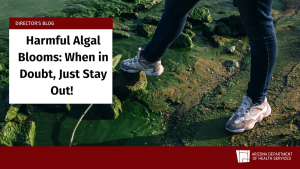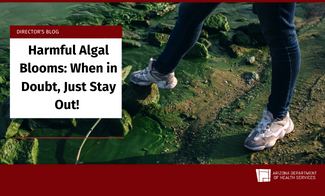 As the weather heats up, many Arizonans head to the water. Whether you’re boating on Lake Havasu, tubing on the Salt River, casting a fishing line at your local park, or taking a dip with your dog, you should know about a little organism that can have a big impact on your health.
As the weather heats up, many Arizonans head to the water. Whether you’re boating on Lake Havasu, tubing on the Salt River, casting a fishing line at your local park, or taking a dip with your dog, you should know about a little organism that can have a big impact on your health.
Algae and cyanobacteria (sometimes called blue-green algae) live in all types of water and rapidly bloom when water’s warm, slow-moving, and full of nutrients. Certain types can result in harmful algal blooms, which are one focus of the ADHS program on Waterborne Diseases.
Ranging in appearance from scummy green globs to blue streaks on the water, all of these can produce toxins and harmful gases that can cause illness and even death in people and animals.
You can’t tell if a large algal growth is harmful just by looking at it, so remember: When in doubt, just stay out.
Don’t get in the water if it:
- Smells bad.
- Looks discolored (algal blooms can be green, blue, brown, red, or other colors.)
- Has foam, scum, algal mats (large floating clumps of algae on the water), or paint-like streaks on the surface.
- Has dead fish or animals along it.
If you, your children, or pets come in contact with algal bloom water, wash the exposed area thoroughly with a safe source of water. Never drink or cook with water that could be contaminated with harmful algae, as boiling the water doesn’t remove toxins and can even concentrate them.
Dog deaths have become an early warning sign of harmful algal blooms, so keep your pooch on a leash near water that may have one. Seek veterinary care immediately if your pets seem sick after going near contaminated water.
Avoid boating and water sports where there’s a bloom. These activities create water spray that can aerosolize toxins and can cause skin, eye, nose, or throat irritation.
Algal toxins can accumulate in fish, so hold off on fishing until a week or two after the water’s clear of blooms. If you do catch fish in HAB water, clean them well with safe water and properly discard the guts.
If you come across what appears to be a harmful algal bloom, you can help keep others safe by reporting it via the Arizona Department of Environmental Quality’s website or its Arizona Water Watch (AZWW) Mobile App.
Symptoms from algal toxins in humans and animals can take anywhere from 15 to 20 minutes to several hours or days to develop. If you think you, your loved one, or pet were exposed to a HAB, there are resources you can call for help.










